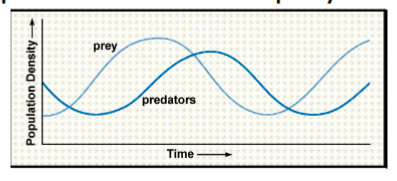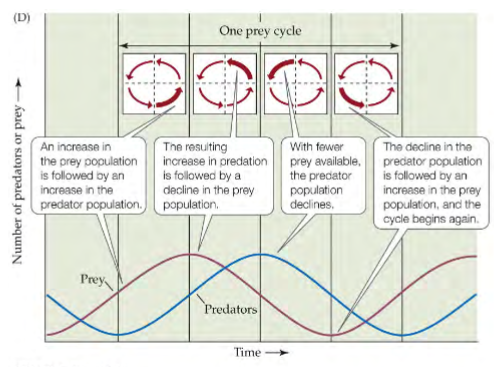Ecology - Mod 11 (Ch 12): Predation and Herbivory
1/25
Earn XP
Description and Tags
Name | Mastery | Learn | Test | Matching | Spaced |
|---|
No study sessions yet.
26 Terms
predator
an organism that catches individuals (prey), kills, and consumes them —> removes individuals from the prey population
herbivore
definition 1) an organism that primarily eats plant material
definition 2) an organism that eats parts of living plants, including tissues or internal fluids, but does not outright kill it
parasite
an organism that consumes parts of a living prey organism (host) in/on which it loves
predator/prey size differences
predators usually larger than prey because large prey may be impossible, dangerous, or energy-costly to subdue and consume
when predators are smaller than prey, can compensate using packs, schools, persistence
adaptations to avoid herbivory
structural defenses (e.g. spines, hairs, tough seed coats)
production of sticky gums and resins (special case: red-cockaded woodpeckers)
production of toxic compounds (e.g. tannins, interfere with digestion of all proteins; other compounds that affect specific metabolic pathways or physiological processes)
masting (synchronized mass fruit/seed production at irregular intervals)
special case: red-cockaded woodpecker
only woodpecker to build nests in live pines
sticky resin of live pines traps insects for woodpeckers to eat
masting
synchronized mass fruit/seed production at irregular intervals
may have evolved to prevent predator satiation (too many to eat them all, not reliable enough to build predator population numbers, not reliable for seed predators to specialize)
other possible reason it evolved: pollination efficiency (optimizes successful pollination and fertilization; especially important for wind-pollinated species)
adaptations to tolerate herbivory
compensation to reduce effects (compensation = increased growth upon removal of tissues)
clipping, in some plants (herbivory → decreased self shading → increased growth → growth of previously dormant axillary buds
adaptations to avoid predation
structural defenses (e.g. armor plates on armadillo, armadillo girdled lizard, spines on catfish, hedgehog, porcupine)
chemical defenses (e.g. poison, venom, foul smell)
behavioral defenses (e.g. running, early detection, seeking refuge, sacrificing body parts to either escape grip or use as a distraction, appearing larger to intimidate, expelling blood/urine/vomit/feces, feigning death, crypsis, aposematic coloration)
aposematic coloration
certain coloring or marking (usually bright) to warn potential predators that you are bad-tasting, toxic, or dangerous
predators avoid such animals innately or due to learned response after an unpleasant experience
some animals manufacture chemicals, others get them from other plants
types: Mullerian mimicry, Batesian mimicry
types of Batesian mimicry: morphological, behavioral
Mullerian mimicry
noxious species evolve to resemble each other
e.g. monarch, viceroy, and queen butterfly
e.g. British bumblebees
Batesian mimicry
harmless species resemble noxious species
e.g. milk snake vs coral snake
morphological Batesian mimicry
something looks harmful or dangerous but isn’t
e.g. the tip of a leaf is red and looks like a thorn, but isn’t
behavioral Batesian mimicry
a harmless species acts like a noxious species
e.g. speckled rattlesnake, spotted leafnose snake, black racer (shakes tail in leaves)
example: costs of avoiding predators
presence of predators (fish or dragonfly larva) affecting prey (tadpole)
when tadpoles spent a lot of time avoiding predators, their growth rate decreased
see figure 12.10 in text
adaptations to improve predation
camouflage (e.g. spider blending in with flower, cheetah, octopus)
speed (e.g. cheetah)
weapons (e.g. fangs, claws)
keen senses (e.g. owl eyes, snake nose)
example: costs to adaptations improving predation
newts have toxins in skin, but some snakes are resistant
resistant snakes may be immobilized for hours
toxicity and resistance vary between populations
populations with snakes more resistant to toxin move slower
coevolution
a series of reciprocal evolutionary adaptations in 2 species
e.g. Heliconius and passion flowers
Heliconius lays eggs on passionflowers, caterpillars feed on sleeves
flower produces a toxin, caterpillars become resistant to toxin
flower produces sugar deposits that attract ants/wasps that prey on butterfly and mimic eggs so it won’t lay more eggs
oscillation
repetitive variation in magnitude around a central point or between two different states
populations that oscillate typically exceed carrying capacity and then fall well below K with relatively regular periodicity
may be caused by predator-prey interactions
predator-prey cycles
often cycle at similar frequencies, with predators slightly lagging behind due to delayed density dependence
e.g. small herbivores and their predators have cycles of 4 years, larger herbivores and their predators have cycles of 9-10 years in Canada
predators eat prey, reduce prey numbers
predators go hungry, predator numbers drop
remaining prey survive better, prey numbers build
predator populations build as prey increases

example: lab investigation of predators and prey dynamics
G.F. Gause
Paramecium and Didinium in an enclosure, with and without refuge
without refuge: predator devoured all prey, then went extinct itself
with refuge: some prey escaped predation, then prey population reexpanded after the predator went extinct
could maintain predator-prey cycles by periodically adding more predators (i.e. immigration)
see figures 12.15 and 12.16
Lotka-Volterra model of prey population
modification of exponential growth formula
without predation, prey population will grow exponentially
dN/dt = rate of change in prey population
rN = exponential growth in absence of predators
aNP = amount that predation reduces the growth rate of the prey population (i.e. how many prey are removed from the population by predators)
N = # of prey (more prey = easier to catch)
r = prey’s per capita exponential growth rate
P = # of predators (more predators = more prey caught)
a = efficiency of predation (more efficient predators = more prey caught)

Lotka-Volterra model: predator population
dP/dt = rate of change in predator population
f = conversion of prey to predator population growth (efficiency of converting food (consumed prey) to population growth)
aNP = removal of prey by predators
mP = death (mortality) rate of predators regardless of prey availability
P = # of predators
N = # of prey
a = constant expressing efficiency of predation
m = constant related to death of predators

zero growth isoclines
conditions required for a population size to stay constant
(i.e. dN/dt = 0 or dP/dt = 0)
prey: dN/dt = rN - aNP = 0 when P = r/a (r/a = # of predators causing the prey population to stay constant)
predators: dP/dt = faNP - mP = 0 when N = m/fa (m/fa = # of prey causing the predator population to stay constant)
Lotka-Volterra predator-prey model oscillations
changes in P and N are represented by vectors, combined into a single vector within quadrants
the vector in each quadrant corresponds to a region on a population cycle graph
predator population cycles lag slightly behind prey population
further population sizes are from equilibrium —> larger amplitude of cycles —> less likely to return to stability

problem with Lotka-Volterra model
the model assumes that there is a lack of satiation of predators
i.e. predators never get full